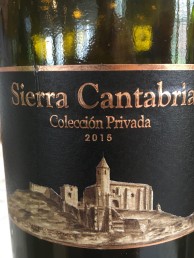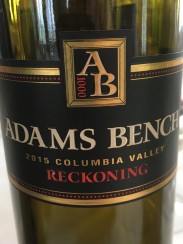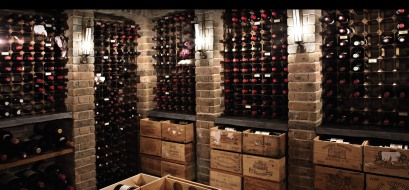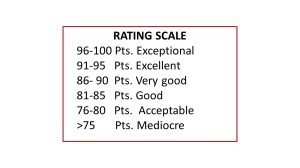Capri Ristorante – McLean, VA
TASTING OVERVIEW
This blind presentation includes four red wines made of four well known varieties or blends of them from four regions where these wines are typical. The objective of the tasting is to find out the region of origin and the varieties of which the wines are made of as well as ranking of preference by the participants.
TYPE : Blind
- 2015 Sierra Cantabria Rioja Coleccion Privada, Tempranillo
- 2015 Adams Bench Reckoning, Red, Columbia Valley
- 2015 Chateau la Pointe, Pomerol
- 2005 Poesía, Red, Mendoza
THE MENU
- Gnocci “Au-Gratin”
- Chicken Marsala
- Vitello Alla Parmigiana
- Dessert and/or coffee
PRESENTERS: Juan Luis Colaiacovo, Ricardo Santiago
PARTICIPANTS: Mario Aguilar, Juan Luis Colaiacovo, Orlando Mason, Italo Mikow,, Ricardo Santiago, Alfonso Sanchez, Jairo Sanchez
INFORMATION ON THE WINES
(All information obtained and condensed from several Internet articles.)
2015 Sierra Cantabria Rioja Coleccion Privada
 The Wine: Vinous-Rioja, Spain – “High-pitched red/blue fruit, floral pastille, spicecake, coconut & allspice aromas, along with a smoky mineral quality that emerges with aeration… Shows excellent clarity & repeating florality on a very long, spicy finish that’s given shape by supple, even tannins.”
The Wine: Vinous-Rioja, Spain – “High-pitched red/blue fruit, floral pastille, spicecake, coconut & allspice aromas, along with a smoky mineral quality that emerges with aeration… Shows excellent clarity & repeating florality on a very long, spicy finish that’s given shape by supple, even tannins.”
The Winery: (From: Jorge Ordoñez Selections) Bodegas Sierra Cantabria was founded by Guillermo Eguren, a self-made bodeguero, who was, in the family tradition, a viticulturist. His family, native to San Vicente de La Sonsierra, one of the most sought after terroirs in Rioja, had grown grapes in Rioja Alavesa since the 1870’s. For decades the family sold their grapes to local producers, but Guillermo recognized the potential that his family’s vineyards had to create great wine, and founded Bodegas Sierra Cantabria in 1957. Today, the fourth generation of the Eguren family directs all aspects of the winemaking process, with Marcos Eguren as the winemaker and director of operations and his brother Miguel Angel Eguren as the general manager. The family still prides themselves as viticulturists first, and as a result, all of the grapes are estate grown, and they do not source fruit from any third party source. As viticulturists in Rioja Alavesa, they grow a vast majority of Tempranillo, with only a small percentage of Garnacha and Graciano, as they recognize that Garnacha and Graciano do not ripen reliably in northern Rioja, and they do not want to source their Garnacha and Graciano from Rioja Baja.
Bodegas Sierra Cantabria is the family’s original winery, and comprises a collection of their most classic style Rioja wines. Due to their viticultural background, the family’s wines are composed of mostly Tempranillo, as they recognize that Garnacha and Graciano do not ripen reliably in Northern Rioja.
Although the family’s business has evolved over the years through the foundation of other projects, Bodegas Sierra Cantabria comprises their most traditional, classic styled wines. The wines are made from a blend of selected vineyards, as opposed to Viñedos Sierra Cantabria, which is the family’s collection of single vineyard wines.
2015 Adams Bench Reckoning, Red, Columbia Valley
 The Wine: (From: Advinetures) This is a Bordeaux type blend based on Cabernet Sauvignon. This blend of 60% Cabernet Sauvignon, 34% Merlot and 6% Petit Verdot takes its name from the bench outside the principal’s office where students would wait to face their reckoning. Very suave, this shows its red and black fruits profile in a medium+ body. Black cherry, plum and blackberry are supported by hints of baking spice. The terrific balance gives it a smooth mouthfeel. Ripe tannins create definition but do not distract. Polished and refined.
The Wine: (From: Advinetures) This is a Bordeaux type blend based on Cabernet Sauvignon. This blend of 60% Cabernet Sauvignon, 34% Merlot and 6% Petit Verdot takes its name from the bench outside the principal’s office where students would wait to face their reckoning. Very suave, this shows its red and black fruits profile in a medium+ body. Black cherry, plum and blackberry are supported by hints of baking spice. The terrific balance gives it a smooth mouthfeel. Ripe tannins create definition but do not distract. Polished and refined.
The Winery: Tim Blue and Erica Blue’s Adams Bench debuted in 2005 with their first vintage. Tim, an attorney, and Erica, a physician, had found the perfect spot for this labor of love in a beautiful property above the Hollywood Hill winery area in Woodinville. Tim and Erica’s wines have a stellar reputation, and have been praised by Wine Spectator, The Wine Advocate, and more, with their wines very often earning ratings well above 90 points. Their fruit is hand picked, whole berry fermented, and bottled without filtration, and they feel treating the young wine with respect shows through when the wines are released.
2015 Chateau la Pointe, Pomerol
 The Wine: RP :The 2015 La Pointe is a blend of 84% Merlot and 16% Cabernet Franc, picked between 27 September for the younger vines for the second wines, and 1 October for the heart of the Merlot, the Cabernet picked 8 and 12 October. Eric Monnoret told me that the 2015 was matured in 50% new oak. It has a comparatively flamboyant bouquet compared to recent vintages of La Pointe, with opulent red berry fruit, kirsch, cassis and patina of tar. The palate is medium-bodied, firm in the mouth at the moment, quite structured, the oak nicely integrated with a slightly savory finish. This is a robust La Pointe, quite spicy in the mouth with a long aftertaste. It will gain more harmony during its élevage.
The Wine: RP :The 2015 La Pointe is a blend of 84% Merlot and 16% Cabernet Franc, picked between 27 September for the younger vines for the second wines, and 1 October for the heart of the Merlot, the Cabernet picked 8 and 12 October. Eric Monnoret told me that the 2015 was matured in 50% new oak. It has a comparatively flamboyant bouquet compared to recent vintages of La Pointe, with opulent red berry fruit, kirsch, cassis and patina of tar. The palate is medium-bodied, firm in the mouth at the moment, quite structured, the oak nicely integrated with a slightly savory finish. This is a robust La Pointe, quite spicy in the mouth with a long aftertaste. It will gain more harmony during its élevage.
The Winery: (From Wine-Seracher) Château La Pointe is one of the largest wine estates in Pomerol, making a Merlot-dominant wine. It dates back to 1845, and has been controlled by the d’Arfeuille family since 1941.The La Pointe estate consists of 23 hectares (57 acres) of vineyards planted mostly to Merlot with some Cabernet Francon a mix of gravel, clay-gravel and sandy soils. These sit on a terrace below the main Pomerol plateau, near châteaux Neninand Trotanoy. The estate also boasts 2ha (5 acres) of formal gardens, and in 1868 was one of the first two estates in the appellation to be allowed to call itself a château. The name La Pointe comes from a sharply angled triangular plot near the entrance to the property.
The vineyard is managed plot-by-plot, and individual parcels of fruit are vinified in small vats. Wines are aged in oak barrels, 50 percent of which are new.Since 2006, Château La Pointe has been owned by the Generali France insurance company. Since then, there have been several key improvements to both viticulture and winemaking. These have included removing Cabernet Sauvignon vines, improving vineyard drainage and lowering the yield of Cabernet Franc, as well as renovating the winery’s vat room.
2005 Poesía, Red, Mendoza
 The Wine: (RP): “The winery’s flagship is called Poesia and is a blend of 60% Malbec and 40% Cabernet Sauvignon. It too is sourced from an 80 year old vineyard in Lujan de Cuyo. The 2005 Poesia was barrel-fermented and aged for 18 months in 100% new French oak. Opaque purple-colored, it has a high-class aromatic array of pain grille, violets, spice box, black cherry, and blueberry. Smooth-textured, ripe, and sweetly-fruited, this elegant wine is beautifully balanced, nicely concealing enough structure to permit 5-7 years of evolution.”
The Wine: (RP): “The winery’s flagship is called Poesia and is a blend of 60% Malbec and 40% Cabernet Sauvignon. It too is sourced from an 80 year old vineyard in Lujan de Cuyo. The 2005 Poesia was barrel-fermented and aged for 18 months in 100% new French oak. Opaque purple-colored, it has a high-class aromatic array of pain grille, violets, spice box, black cherry, and blueberry. Smooth-textured, ripe, and sweetly-fruited, this elegant wine is beautifully balanced, nicely concealing enough structure to permit 5-7 years of evolution.”
The Winery: (From WS) Poesia, which means poetry in Spanish, is the latest project of Hélène Garcin-Lévêque, 30, and her husband, winemaker Patrice Lévêque, 36. Garcin and Lévêque are no strangers to wine. Garcin manages several small Bordeaux châteaus owned by her mother, Sylviane Garcin-Cathiard, including Clos L’Église in Pomerol and Barde-Haut in St.-Emilion, while Lévêque makes the wines.
The Bordeaux connection to Argentina is already strong, with several joint ventures — such as Bodegas Caro (between Domaines Baron de Rothschild-Lafite and Catena Zapata) and Cheval des Andes (Château Cheval-Blanc and Bodegas Terrazas de los Andes) — producing wines that try to marry the two region’s styles. But Garcin is looking for something different through Poesia.
“We want to have an original Argentinean wine, and not a copy of a blend that is already done in another country,” Garcin said.
Garcin first came to Argentina in 1998 as part of a group of investors in Bodega Monteviejo, a project led by Bordeaux consultant Michel Rolland and located in the Vista Flores area in the Uco Valley. But with progress there sluggish, Garcin changed her plan. She sold some of her parcels to other members of the group and moved up north to the historical heart of Mendoza, Luján de Cuyo. There she purchased a 32-acre vineyard notable for the Malbec that had been planted in 1935.
The vineyard, which also contains Cabernet Sauvignon, is being farmed organically by Garcin and her vineyard manager Marcelo Casazza. Poesia will not use any purchased grapes, and production will be small: Only 1,300 cases were made in 2001 and 2002, and just more than 1,500 cases in 2003. The wine will retail for around $40.
Though Garcin wants to make a uniquely Argentinean wine, she is blending Malbec — the country’s premier grape — with Cabernet Sauvignon, the leading player in Bordeaux. “Cabernet has better body and tannin structure,” she said. “So it gives more complexity to the blend.”
The wine receives 18 months in 100 percent new French oak, but the barrel staves have only a medium to light toast and the barrel heads are not toasted. This light-handed approach to the élevage allows the wine’s purity to shine through. Samples of the 2002 and 2003 tasted with Garcin showed lush raspberry confiture notes supported by racy tannins.
VINOTABLES RATINGS FOR THIS TASTING:
- 2015 Sierra Cantabria Rioja Coleccion Privada, Tempranillo – CV Rating: Very Good to Excellent
- 2015 Adams Bench Reckoning, Red, Columbia Valley – CV Rating: Very Good
- 2015 Chateau la Pointe, Pomerol – CV Rating: Excellent
- 2005 Poesía, Red, Mendoza – CV Rating: Excellent
View full evaluation here: Summary of Tasting Scores 66
Best Rated: 2005 Poesía, Red, Mendoza
Best Buy: 2015 Chateau la Pointe, Pomerol



